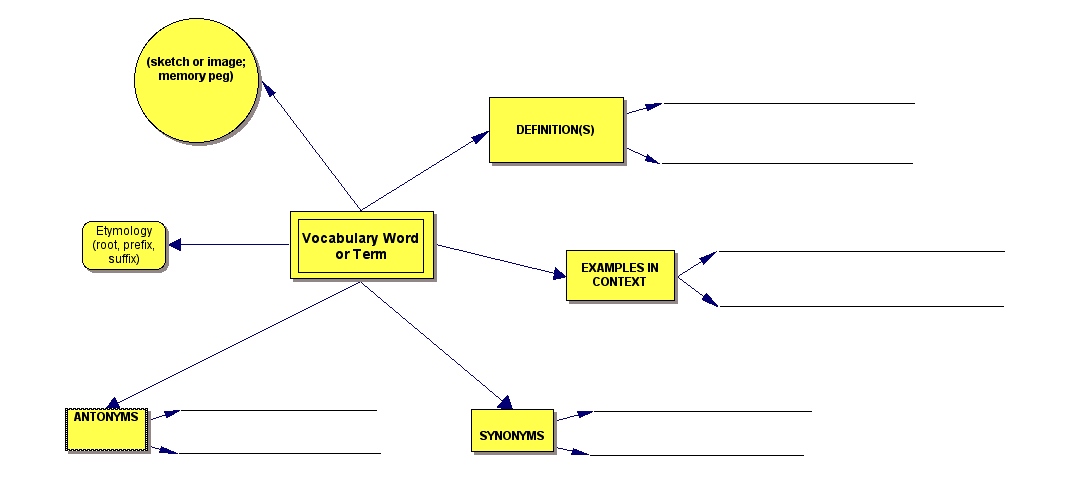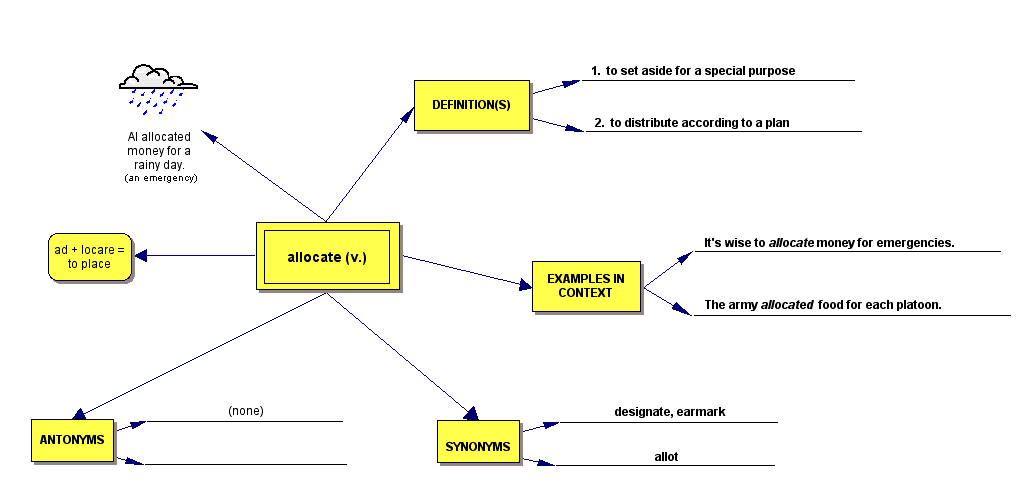LEARNING STYLE STRATEGIES AND VOCABULARY WORD TEMPLATES Learning Style Strategies
This chart summarizes specific, brain-friendly vocabulary techniques for each learning style or “intelligence.” They offer easy, effective, and fun methods for increasing your vocabulary. Try the strategies that match your style. |
|
To store information through . . .
|
You need to . . .
| Verbal-linguistic intelligence | Say and write the word; write the definition in your own words. Example: “A tyrant governs other people; he has all the power, and he causes suffering and pain to those he rules.” | Logical-mathematical intelligence | Compare the word to another word. Example: “A tyrant is like a bully, except that a tyrant rules other people.” | Spatial intelligence | Visualize the word and its definition; visualize an image that illustrates the word. | Bodily-kinesthetic intelligence | Use your hands or body to make a physical gesture that represents the word. Act out the meaning of a word. | Musical intelligence | Associate the word with a song or sound, or sing the word and its definition. Example of sounds: the sound of the tyrant cracking his whip; his yelling at his people; the voices of frightened people. A “song”: “Tyrants rule In a way that's cruel.” | Interpersonal intelligence
(you are able to relate to other people very well) | Study words with a partner; quiz and coach each other. Example: With a classmate, take turns being player and coach. Use the stacks of vocabulary cards you have prepared. The player must define and explain a term. If he or she gets stuck, the coach gives a clue, such as using the word in a sentence. (The coach doesn't give the definition, just a clue.) | Intrapersonal intelligence
(you have great awareness of your own thoughts and feelings) | Determine what the word means at a personal level, or determine how it is relevant to your own life. Repeat the word with emphasized emotion. Personal link: “I once had a coach who was a tyrant. We did exactly as he said. He was mean if you goofed up in any way. Everyone was afraid of him.” | Naturalist intelligence
(you relate well to nature and
the outdoors) | Study the words outside, or develop nature-based associations for each word. Nature link: “A tyrannosaur was a huge, meat-eating dinosaur that other animals were afraid of. The word tyrannosaur means ‘tyrant lizard.'” |
| Notice that the vocabulary cards, as well as the other strategies, work with the way the brain naturally learns. You make personally meaningful associations with information you already know. You see the word in multiple contexts: the sentence in which you found it and your own sentence. You have repeated exposure to the word. You use multi-sensory input. That means you send the information to your brain several different ways—by seeing, saying, hearing, and writing it. They are very powerful, and they make learning more fun! Vocabulary Word Templates
A final organized approach to learning new words is to use a template or pattern like the one below. Diagrams of this sort are also called graphic organizers because you can use them to organize information you need to learn.
To learn vocabulary, write the new word in the middle of the page. From it, branch out and write the meaning, sample sentences that use the word, synonyms, and antonyms (if there are any). If it will help you understand and remember the meaning, include the word's etymology or origin. (You will learn about word origins in Chapter 4, Using the Dictionary, and in the Online Reading Lab material on word structure.) Finally, include a small sketch, a memory peg, or both. Use whatever complements your learning style. |
|  <a onClick="window.open('/olcweb/cgi/pluginpop.cgi?it=jpg::::/sites/dl/free/0073123587/380570/12Chart_A.JPG','popWin', 'width=1116,height=551,resizable,scrollbars');" href="#"><img valign="absmiddle" height="16" width="16" border="0" src="/olcweb/styles/shared/linkicons/image.gif"> (72.0K)</a> <a onClick="window.open('/olcweb/cgi/pluginpop.cgi?it=jpg::::/sites/dl/free/0073123587/380570/12Chart_A.JPG','popWin', 'width=1116,height=551,resizable,scrollbars');" href="#"><img valign="absmiddle" height="16" width="16" border="0" src="/olcweb/styles/shared/linkicons/image.gif"> (72.0K)</a>
| Here is an example of the graphic organizer that has been filled in. The sample word is allocate (a good college-level word!). |
|  <a onClick="window.open('/olcweb/cgi/pluginpop.cgi?it=jpg::::/sites/dl/free/0073123587/380570/12Chart_B.JPG','popWin', 'width=1081,height=564,resizable,scrollbars');" href="#"><img valign="absmiddle" height="16" width="16" border="0" src="/olcweb/styles/shared/linkicons/image.gif"> (148.0K)</a> <a onClick="window.open('/olcweb/cgi/pluginpop.cgi?it=jpg::::/sites/dl/free/0073123587/380570/12Chart_B.JPG','popWin', 'width=1081,height=564,resizable,scrollbars');" href="#"><img valign="absmiddle" height="16" width="16" border="0" src="/olcweb/styles/shared/linkicons/image.gif"> (148.0K)</a>
| Sample the vocabulary building strategies that are described here, and then pick the one or ones that work best for you. www.visualthesaurus.com
If you think visually, check out www.visualthesaurus.com. It's available as a CD or online by subscription, but you take the product tour for free. Also, you can type in a word of your choice to see how it works. That's free, too. This inventive tool is both a thesaurus and a dictionary, and it includes more than 145,000 words. Its interactive display lets you see connections and relationships among words. In addition, it gives synonyms and antonyms, and it includes pronunciations. |
|
Elder, J. Entryways into College Reading and Learning. Copyright © 2008 The McGraw-Hill Companies, Inc. |

